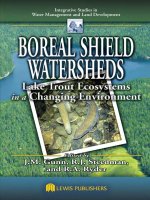Lake Trout Ecosystems in a Changing Environment - Chapter 14 ppt
Bạn đang xem bản rút gọn của tài liệu. Xem và tải ngay bản đầy đủ của tài liệu tại đây (1.16 MB, 14 trang )
© 2004 by CRC Press LLC
chapter fourteen
Effects of forestry roads on
reproductive habitat and
exploitation of lake trout*
John M. Gunn
Ontario Ministry of Natural Resources, Laurentian University
Rod Sein
Ontario Ministry of the Environment
Contents
Introduction
Methods
Whitepine Lake: habitat loss experiment
Helen Lake: verification study
Michaud Lake: exploitation study
Results and discussion
Habitat loss experiment: spawning site selection and quality
Evidence of recruitment failure
Exploitation following improved road access
Conclusions
Acknowledgments
References
Introduction
There are now very few parts of the Boreal Shield area of Ontario that are remote from
access roads (Figure 14.1). This network of roads and associated human-directed impacts
represents a largely unplanned legacy from forestry, mining, and other resource extraction
industries. However, to date, there have been few attempts to measure the impacts of
road-related effects on aquatic ecosystems. To do this, we adopted an experimental
* Modified from Gunn, J.M. and Sein, R., 2000, Effects of forestry roads on reproductive habitat and exploitation
of lake trout (Salvelinus namaycush) in three experimental lakes, Canadian Journal of Fisheries and Aquatic Sciences,
57(Suppl. 2): 97–104.
© 2004 by CRC Press LLC
manipulation approach to test and compare two potential effects of forest access roads
on fish populations: sedimentation and excessive exploitation.
We concentrated our studies on small lakes that supported naturally reproducing
populations of lake trout Salvelinus namaycush, a species that receives special attention in
forestry management plans, particularly in Ontario (Ontario Ministry of Natural
Resources, 1988). Less than 1% of Ontario’s lakes contain this prized sport fish species
(Martin and Olver, 1976), and lake trout are considered highly sensitive to the disturbances
that often accompany forestry operations. Under current guidelines in Ontario (Ontario
Ministry of Natural Resources, 1988) all lake trout lakes must have terrestrial buffer strips
(depending on slopes) of 30 to 90 m left around the entire shoreline, within which no road
construction or tree harvesting is allowed. Road crossings of streams as potential point
sources of sediment appear to represent more of a threat to nearshore spawning habitat
of lake trout than silt inputs from clear-cut logging areas. Clear-cut areas in the low-relief
landscape of much of the Boreal forest appear to have few, and probably quite temporary,
effects on sediment transport to lakes (Blais et al., 1998; Steedman and France, 1999).
Spawning sites are identified as “critical fish habitat” in the guidelines and are con-
sidered essential areas that must be protected from sedimentation (Ontario Ministry of
Natural Resources, 1988). The reproductive habitat is considered particularly vulnerable
because the lake trout is a demersal spawner (Figure 14.2a and 14.2b) that broadcasts its
eggs over clean, coarse substrates in very shallow (<2 m deep) nearshore (<10 m from
shore) waters in small Shield lakes (Martin, 1957; DeRoche, 1969; McMurtry, 1986; Gunn,
1995). The developing embryos are deep in the interstitial spaces of the substrate for over
7 months (October to early May) and can readily be suffocated by sediments eroding from
the catchment (Sly and Evans, 1996).
Ontario forestry guidelines and management plans usually give inadequate consid-
eration to the very low productivity and high exploitation vulnerability typical of lake
trout lakes (Ryder and Johnson, 1972; Shuter et al., 1998). Estimates of the sustainable
harvest levels for lake trout populations are usually less than 1 kg⋅ha
−1
⋅yr
−1
(Healey, 1978;
Martin and Olver, 1980). Shuter et al. (1998), using a simulation model they developed,
Figure 14.1 Areas within the outlined Boreal Shield landscape of Ontario, Canada, that are more
than 10 km from roads. The locations of our study lakes are indicated. (Data provided by Ontario
Ministry of Natural Resources.)
© 2004 by CRC Press LLC
predicted that small (100 ha) lakes on the Shield are more productive (maximum sustainable
harvest of approximately 1.5 kg lake trout⋅ha
−1
⋅yr
−1
) than larger (1,000 to 10,000 ha) lakes,
but are extremely vulnerable to overfishing. They estimated that small lakes might not be
able to sustain more than approximately 7 h of fishing effort⋅ha
−1
⋅yr
−1
(Shuter et al., 1998).
We used three small lakes to test the effects of spawning habitat loss and exploitation
on lake trout populations. In Whitepine Lake, we used opaque plastic sheeting and during
1992 to 1999 progressively covered available nearshore spawning habitat to simulate the
effect of a sediment discharge to the lake (Figures 14.3 and 14.4). Helen Lake was added to
the study in 1999 to verify the results of the habitat manipulation experiment using a lake
with a more complex fish community. In Michaud Lake, we assessed the effects of exploi-
tation on a remote lake when fishing resumed after a 7-year closure period, 1991 to 1997.
Improved access to the lake was provided by the construction of a forest access road in 1994.
Methods
The three study lakes are all small (67- to 148-ha) headwater lakes located 40 to 90 km
from Sudbury, Ontario (Figure 14.1), and are located within the Boreal Shield ecozone.
(a)
(b)
Figure 14.2 (a) Photo of spawning lake trout at Ox Narrows. (Photo by S. Skulason.) (b) Spawning
lake trout on Whitepine Lake; note the clean coarse substrate where eggs are deposited. The egg
collector is 30 cm in diameter. (Photo by S. McAugley.) See color figures following page 200.
© 2004 by CRC Press LLC
The two principal study lakes, Whitepine and Michaud, have very simple fish communi-
ties dominated by small-bodied lake trout, typical of populations with a mainly planktiv-
orous or insectivorous diet. Other species present in the lakes include yellow perch Perca
flavescens, Iowa darters Etheostoma exile, common white suckers Catostomus commersoni,
and a few species of cyprinids. The lakes had previously been used in a variety of research
projects related to acid rain (Gunn et al., 1987; Gunn and Keller, 1984, 1990) and had very
similar histories. In the early 1980s they were both acidified (pH < 5.5), and their native
lake trout populations were reduced to small remnant stocks of nonreproducing adults.
Figure 14.3 Aerial view of the habitat manipulation experiment. Opaque plastic sheeting was used
to progressively cover lake trout spawning sites along the shore.
Figure 14.4 Installation of the plastic tarps to cover one of the largest of the traditional spawning
sites on Whitepine Lake.
© 2004 by CRC Press LLC
Water quality improved throughout the 1980s because of reductions in emissions of SO
2
in Canada and the United States (Gunn and Keller, 1990).
Both principal study lakes were stocked with hatchery-reared lake trout to assist in
rehabilitation. In Whitepine Lake, the hatchery stocking only occurred in 1980 and 1981
and then was stopped because the native population resumed reproduction in 1982.
Reproduction occurred yearly thereafter, and a dense population of lake trout developed
in Whitepine Lake by 1990. In Michaud Lake the native fish disappeared before natural
recruitment resumed, and the hatchery stocking that began in 1984 was maintained peri-
odically until 1992. Natural reproduction of the hatchery stocked fish in Michaud Lake
began in 1990. A permanent sanctuary status was established for Whitepine Lake in 1980
to prevent angling exploitation. On Michaud Lake a temporary angling closure (1991 to
1997) was established.
Helen Lake (46°06′ N, 81°33′ E, 82 ha, 41.2 m maximum depth, 20.5 m mean depth)
was a near-pristine lake located within the wilderness setting of Killarney Provincial Park
and was used as an alternate lake to test the habitat manipulation technique. It has good
water quality, a native reproducing lake trout population, and a complex fish community.
In addition to lake trout it contains smallmouth bass Micropterus dolomieu, rock bass
Ambloplites rupestris, cisco Coregonus artedi, brown bullhead Ameriurus nebulosus, bluegill
Lepomis macrochirus, pumpkinseed Lepomis gibbosus, yellow perch, slimy sculpin Cottus
cognatus, Iowa darter, and bluntnose minnow Pimephales notatus. Helen Lake is open to
angling, but angling pressure is quite low because of its location and the fact that motorized
access is prohibited.
Whitepine Lake: habitat loss experiment
Whitepine Lake was used as the principal experimental lake to test the hypothesis that
spawning habitat reduction in shoreline areas would lead to recruitment failures in native
lake trout populations. Previous publications from this experiment dealt with the behav-
ioral response of fish to the habitat disturbances (McAughey and Gunn, 1995) and the
accuracy of visual techniques of classifying spawning habitat (Gunn et al., 1996).
Whitepine Lake (47°17′ N, 80°50′ W) is a 67-ha lake (22 m maximum depth, 5.9 m
mean depth) with a 4.7-km shoreline. It has a 328-ha terrestrial catchment area consisting
of thin sandy soil over granitic bedrock and has a few small wetland areas. The area was
logged in the past, and approximately 30% of the catchment was burned in 1975. At the
start of this experiment in 1991 the forest cover was dominated by white pine Pinus strobus
except for the burned area, where an early successional mixed cover existed. A band of
trees and shrubs occurred along almost the entire shoreline, and there was no evidence
of severe water-level fluctuations or excessive erosion or siltation. Few human distur-
bances existed in the area. Our small research cabin is the only building in the catchment
area.
The habitat manipulation experiment began in October 1991 by mapping all of the
traditional spawning sites used by lake trout. Spawning fish were located by cruising the
entire shoreline each night of the spawning season (10 to 20 days in October) and spotting,
with the aid of flashlights, spawning groups of lake trout over shallow (<2 m) nearshore
areas of clean, coarse substrate. Associated studies have shown that lake trout in this lake
select substrate that has a diameter of 2 to 10 cm (Gunn, 1995). Identified sites were later
confirmed by examining the substrate for the presence of deposited eggs. In 1991 and
1992 egg deposition rates were measured using funnel collectors buried in the substrate
(Gunn, 1995; Figure 14.2b). In subsequent years only the presence or absence of eggs was
recorded. Frequent searches by boat and by diving eliminated the possibility of any
© 2004 by CRC Press LLC
undetected offshore sites in this study. This was also confirmed by tracking spawning fish
tagged with ultrasonic transmitters.
The habitat manipulation began in 1992 by covering the spawning substrate with
opaque plastic sheeting, which was left in place throughout the entire period of the
experiment. The original spawning sites (seven sites, total surface area 40 m
2
) were
removed as follows: 15% by area in 1992, 35% in 1993, 50% in 1994. Testing of the
manipulation technique was done in 1995 by covering six previously used sites with sand
as a more “natural” disturbance. Fish avoided sites covered with both plastic sheeting
and sand. Therefore, only the plastic sheeting method was used to cover spawning sites
in 1996, 1997, and 1998.
In addition to the annual assessment of spawning activity described above, we con-
ducted detailed studies of annual abundance and size structure of the population. Popu-
lation estimates were conducted in the spring (water temperature 6 to 15°C) by the
continuous mark–recapture Schnabel method (Ricker, 1975). Fish were captured by angling
or by using short-duration (30-min) sets of small mesh (38- to 51-mm stretched mesh) gill
nets, and low handling mortality was confirmed through holding experiments (McAughey
and Gunn, 1995). Accurate age assessment of the fish using otoliths was not possible
because of the impact that lethal sampling for aging structures might cause. Instead,
estimates of juvenile (<370 mm) abundance were made in terms of body size; these
estimates were based on the assumption that the size-at-maturity relationships observed
during the 1994 (Gunn et al., 1996) and 1997 spawning assessments applied throughout.
To eliminate resampling the same fish, all captured-and-released juveniles were given a
permanent adipose clip. To ensure detection of year-class failure, we attempted to capture
and mark at least 100 juveniles each year.
The physical characteristics (depth, distance from shore, substrate size, and depth of
interstitial spaces) of all new spawning sites were measured shortly after egg deposition
ended. The location of the eggs was marked with a numbered brick, and a qualitative
assessment of over-winter survival was then conducted by divers in late April to early
May by excavating the sites and noting the presence or absence of live alevins.
Helen Lake: verification study
A test of the habitat manipulation technique was conducted in Helen Lake in 1999 to
verify that the results in Whitepine Lake were not site specific or related to the absence
of potential egg predators in the principal study site. Traditional spawning sites on Helen
Lake were mapped in 1997 and 1998. In 1999 all five traditional spawning sites were
covered with plastic sheeting, and the newly selected sites were located, marked, and
assessed for alevin survival following the methods described above.
Michaud Lake: exploitation study
The exploitation experiment involved the assessment of the immediate impact of anglers
on a remote lake (Michaud Lake) following construction of a forest access road and the
lifting of the fishing ban. The final 12 km of a 26-km forest access road to Michaud Lake
(46°49′ N, 81°18′ W, 148 ha, 24 m maximum depth, 7.0 m mean depth) was completed in
1994 providing access for snow machines and four-wheel-drive vehicles to within 100 m
of the lake. In the summer of 1997 a netting survey was conducted to assess the relative
abundance of lake trout in the lake. In the fall (October 1 to 30, 1997) a spawning assessment
of adult lake trout in Michaud Lake was conducted, and 220 adults were fin marked and
released.
© 2004 by CRC Press LLC
On January 1, 1998, the fishing season opened under the standard regulations (unlim-
ited entry and access, daily possession limit of three lake trout⋅angler
−1
). No attempt was
made to encourage fishing on the lake. There were no public notices in newspapers or
elsewhere (the published regulations were actually in error and still indicated that the
lake was closed to fishing), and there were no road signs to assist in locating the lake
among the many other lakes and forest roads in the area. The newly constructed road was
not plowed, so anglers had to use snowmobiles for the final 12 km to reach the lake. Once
the fishing began, a random, stratified (by weekday or weekend day) creel survey was
conducted to assess angling effort and harvest. The creel survey was maintained through-
out the winter and early spring of 1998. Netting and spawning surveys were repeated in
the summer and fall of 1998 to assess the effects of angling on the lake trout population.
Results and discussion
Habitat loss experiment: spawning site selection and quality
Lake trout proved to be highly adaptable to spawning habitat disturbances and repeatedly
selected new sites in Whitepine Lake when previous spawning sites were covered. Similar
results were found in Helen Lake, where nine new sites were selected after the traditional
sites were covered (Table 14.1; Figure 14.5). In total, over 250 new spawning sites were
selected in Whitepine Lake because of our experimental manipulations (Table 14.1; Figure
14.5). The accumulated impact of removing access to over 1600 m
2
of substrate during
this 9-year experiment in Whitepine Lake did not prevent fish from spawning; however,
it did appear to represent a severe enough impact that fish were forced to select what
appeared to be marginal habitat. All the newly selected spawning sites in Whitepine Lake
had at least a small patch of substrate within the preferred range (diameter of 2 to 10 cm),
but many of the sites were very small (surface area <0.2 m
2
), had limited interstitial space
beneath the substrate for eggs to settle (Figure 14.6), and were in shallow water (<0.4 m)
where eggs appeared to be highly vulnerable to both predation and ice damage (Table
14.1). In the few relatively large sites, eggs were thinly dispersed and appeared to have
drifted considerable distances before they became wedged within the substrate. The large
number of widely dispersed sites (Figure 14.5) was further evidence of the severe distur-
bance imposed by the habitat removal. Lake trout usually spawn en masse (Figure 14.2a
and 14.b) at relatively few sites (Martin, 1957; DeRoche, 1969; Gunn, 1995). It is rare to
find an inland lake trout lake with more than ten traditional spawning sites, including
lakes much larger than Whitepine (McMurtry, 1986).
In the early years of the study the trout exhibited strong fidelity to the seven traditional
sites (Gunn, 1995; McAughey and Gunn, 1995). However, as the study proceeded it became
evident that prior experience with a site proved unnecessary. Learned behaviors or
chemosensory cues from previous use of a site (Foster, 1985; Hara, 1994) may assist a fish
in returning to a site, but our study showed that the innate behavior of being able to
readily identify usable habitat is very powerful in this species.
Evidence of recruitment failure
We were not able to accurately quantify egg deposition rate or survival rates of incubating
embryos, but the new sites continued to produce alevins each year (Table 14.1), demon-
strating that recruitment was not eliminated by the habitat disturbances. In the final year
of the study, 21 of the 41 sites (51.2%) on Whitepine Lake contained live alevins on May 2,
2000. The presence of live alevins in the majority of the sites on Whitepine Lake occurred
even though the amount of potential habitat lost during the experiment was more than
© 2004 by CRC Press LLC
Table 14.1 Whitepine Lake and Helen Lake Spawning Sites
Spawning sites used Site characteristics Spawning habitat covered
Year Number
Total area
(m
2
)
Surface area
(m
2
)
Water depth
(m
2
)
Distance
from shore
(m)
Sites
producing alevins
(%)
Egg
deposition area
(m
2
)
Adjoining
areas
(m
2
)
Totals
(m
2
)
Whitepine Lake
1991 7 40.0 0.5–21.0 0.3–1.5 1.4–4.5 na 0 0 0
1992 15 74.8 0.5–21.0 0.2–2.0 na* na 6.0 86.0 92.0
1993 18 64.9 0.5–21.0 0.1–1.2 na 44.4 13.0 86.0 99.0
1994 41 40.3 0.1–5.0 0.1–2.0 0.5–4.0 na 21.0 71.0 92.0
1995 44 82.7 0.2–10.0 0.3–0.8 0.3–0.9 na 6.0 0 6.0
1996 39 195.3 0.9–42.0 0.1–1.5 0.4–2.7 76.9 189.0 101.6 290.6
1997 52 126.3 0.1–15.0 0.1–1.4 0.4–6.0 44.3 195.3 28.4 223.7
1998 41 226.4 0.1–78.9 0.2–1.3 0.8–6.0 46.3 126.3 68.9 195.2
1999 41 98.1 0.1–13.2 0.2–1.5 0.2–15.0 51.2 226.4 378.6 605.0
Helen Lake
1997 5 11.5 0.2–9.0 0.5–0.7 na 40.0 0 0 0
1999 9 44.2 0.2–15.0 0.3–0.8 na 55.5 11.5 138.5 150
Note: Spawning sites were defined as the area of egg deposition during the fall spawning period. Substrates were inspected immediately after ice off in April and early
May to identify spawning sites that produced alevins. On Whitepine Lake the traditional spawning sites were gradually covered with plastic sheeting 1992 through
1994. During 1996 through 1999 (Whitepine Lake) and 1999 (Helen Lake) all previous spawning sites were covered each year.
* na, not available.
© 2004 by CRC Press LLC
40 times that of the original area of substrate that supported the population in 1991. Similar
results occurred in the 1-year manipulation of Helen Lake, where five of nine (55.5%)
newly selected sites contained alevins on April 18, 2000.
The mark–recapture estimates of juvenile abundance on Whitepine Lake also failed
to show any of the expected effects of the experimental treatment. We predicted that
juvenile abundance would decline as a result of the habitat loss, expecting the decline to
begin soon after all the traditional spawning sites were removed in 1994. The mean size
of fish in the index gill nets was also expected to increase with time if abundance of
juveniles, and resulting competition for food, declined.
There was no decline in the abundance of juveniles (fork length [FL] 260 to 370 mm)
detected during the study (Table 14.2). The average size of fish in the population also did
not increase (Figure 14.7), giving further evidence that recruitment was unaffected by the
habitat loss. Age assessment data are not yet available for fish collected during recent
years, but from age–size relationships obtained earlier (Gunn et al., 1996) it is clear that
most of the abundant juveniles in Whitepine Lake are recruits from the new spawning
sites. The difficulty in capturing very young fish (<3 years old) with our assessment
methods means that year-class declines may still be detected in the future as a result of
Figure 14.5 Locations of traditional spawning sites and the spawning sites used after the habitat
manipulation experiment was completed in Whitepine Lake (1991, 1999) and Helen Lake (1998,
1999) (marked with •). The locations of spawning sites that were covered for this experiment are
indicated (marked with +).
© 2004 by CRC Press LLC
possible reduction in the survival of the egg–alevin stages in the later years of the study.
However, the continued production of alevins at the alternate sites throughout the study
suggests that the habitat manipulations (i.e., continued removal) would have to be con-
tinued for many more years to detect a complete loss of recruitment.
Exploitation following improved road access
The effects of exploitation on Michaud Lake were not subtle. Fishermen were able to access
the lake in midwinter by the new road. Anglers used snowmobiles and all-terrain four-
wheel-drive vehicles to travel to the lake. Catch rates (Figure 14.8a) were very high when
the fishery opened in the first week of January 1998 (0.4 fish⋅angler⋅h
−1
), and most anglers
were able to catch their allowable limit of three fish each day (angler-day). The number
of angler-days increased steadily, reaching a maximum of 93 in the fourth week of January
(Figure 14.8b).
Figure 14.6 One of the alternate sites on Whitepine Lake. This alternate site, like many others,
appeared to have very marginal conditions (i.e., <10 cm deep, underlain by sand with little interstitial
space for eggs).
Table 14.2 Estimated Abundance of Juvenile (260 to 370 mm) Lake Trout in
Whitepine Lake from the Springtime Surveys
Year Number Marked Recaptured (%) Estimated Total Number
1992 17 0 —
1993 63 22 180 (118–377)
1994 110 19 406 (284–709)
1995 77 10 507 (300–1653)
1996 45 16 169 (97–653)
1997 75 13 357 (220–938)
1998 89 6 955 (509–7738)
1999 139 9 1013 (647–2332)
Note: Abundance was estimated by Schnabel continuous mark-recapture of angled and gill
netted fish. Estimated numbers with 95% confidence intervals (in parentheses) are
presented.
© 2004 by CRC Press LLC
The sustainable yield (kg⋅ha
−1
) level for Michaud, a 148-ha lake, was estimated as 1.35
kg⋅ha
−1
from the following equation of Payne et al. (1990) (Figure 14.8c):
Log
10
(Harvest) = 0.50 + 0.83⋅log
10
(Area)
The estimated maximum sustainable yield level was exceeded less than 3 weeks after
anglers accessed the lake (Figure 14.8c). Fishing success rate declined through the winter,
but anglers continued to harvest lake trout until ice melt forced an end to the fishery. Once
the road was dry enough to permit truck travel, anglers brought boats to the lake and
began fishing again on April 24. Fishing success rates improved for a brief period in the
open-water period, but declined rapidly. Anglers largely abandoned the lake in early May.
In this brief fishery the estimated harvest reached 3.8 kg⋅ha
−1
in fewer than 5 months.
A total of 395 harvested fish were observed by the creel survey crews. Of the creel survey
sample 22% were fin clipped, providing a mark–recapture estimate of 765 (95% confidence
interval [CI], 607 to 963) for the preangling adult portion of the population. This population
was reduced by approximately 72% (final population estimate 210; 95%CI, 52 to 408) in
the winter and spring fisheries. The midsummer index netting survey provided consistent
evidence of the population decline. Average catch rates of lake trout declined by 70%
between 1997 and 1998 (Table 14.3).
Conclusions
The results of this study suggest that lake trout were not particularly vulnerable to damage
from the physical alterations to spawning habitat that may occur through the construction
of forest access roads in Boreal Shield areas of Ontario. First, there are management
guidelines in place (e.g., Ontario Ministry of Natural Resources, 1988, 1990, 1991) for the
construction of roads; if followed, the guidelines should limit siltation of streambeds and
inlet areas of lakes. Unlike other Salvelinus species such as brook trout (Curry et al., 1997),
lake trout appear rarely, if ever, to use streams or the area immediately adjoining inlet
streams for spawning. In a survey of 95 lake trout lakes, McMurtry (1986) found that no
Figure 14.7 The size of lake trout captured in the index gill nets in Whitepine Lake, 1991 to 1999.
Annual median, 25th percentile, 75th percentile, maximum, minimum, and sample size indicated.
© 2004 by CRC Press LLC
lake trout spawning sites were within 20 m of a stream inlet. Our study showed that if
siltation of shorelines did actually occur, lake trout would seek spawning sites elsewhere
and could maintain recruitment at these alternate sites. Siltation events would have to be
extremely extensive and long lasting to eliminate reproduction completely in this long-
lived species.
The fact that we have not yet detected a substantial effect of progressive spawning
habitat loss on lake trout recruitment in two experimental lakes does not mean that there
Figure 14.8 Weekly estimates of the number of a) fish captured per angler hour (lake trout/hour),
b) anglers (wk
−1
), and c) accumulated harvest (kg ha
−1
) of lake trout in Michaud Lake during the
winter and spring of 1998, the year the lake opened to fishing.
© 2004 by CRC Press LLC
is an unlimited supply of suitable spawning habitat on Shield lakes, or that lake managers
should be any less diligent about protecting fish habitat from disturbances. Spawning
habitat loss is surely one of a suite of stressors that have a cumulative effect on lake trout.
However, our experimental results clearly suggest that resource managers need to question
whether fish harvest controls and improved motor vehicle access to lake trout lakes have
received sufficient attention in forest and fisheries management planning. We think that
forest access roads and the increases in angling pressure they create have a far greater
impact on Boreal Shield lake trout populations than spawning habitat loss due to sedi-
mentation.
Acknowledgments
We appreciate the assistance of Robert Kirk, Lee Haslam, Scott McAughey, and David
Gonder, who helped with the fieldwork, and Sylvia Donato for the graphics. Review
comments were kindly provided by Greg Deyne, Warren Dunlop, Dave Evans, Steve Kerr,
Rob Korver, Nigel Lester, Cheryl Lewis, Terry Marshall, Mike Powell, Bev Ritchie, Ed
Snucins, Neville Ward, and two anonymous referees.
References
Anderson, B. and Potts, D.F., 1987, Suspended sediment and turbidity following road construction
and logging in western Montana, Water Resources Bulletin, 23: 681–690.
Blais, J.M., France, R.L., Kimpe, L.E., and Cornett, R.J., 1998, Climatic changes in northwestern
Ontario have had a greater effect on erosion and sediment accumulation than logging and
fire: evidence from 210 Pb chronology in lake sediments, Biogeochemistry, 43: 235–252.
Curry, R.A., Brady, C., Noakes, D.L.G., and Danzman, R.G., 1997, Use of small streams by young
brook trout spawned in a lake, Transactions of the American Fisheries Society, 126: 77–83.
DeRoche, S.E., 1969, Observations on the spawning habits and early life of lake trout, Progressive
Fish Culturist, 31: 109–113.
Foster, N.R., 1985, Lake trout reproductive behavior: influence of chemosensory cues from young-
of-the-year by-products, Transactions of the American Fisheries Society, 114: 794–803.
Gunn, J.M., 1995, Spawning behavior of lake trout: effect on colonization ability, Journal of Great
Lakes Research, 21(Suppl. 1): 323–329.
Gunn, J.M., Conlon, M., Kirk, R.J., and McAughey, S.C., 1996, Can trained observers accurately
identify lake trout spawning habitat? Canadian Journal of Fisheries and Aquatic Sciences, 53(Sup-
pl. 1): 327–331.
Gunn, J.M. and Keller, W., 1984, Spawning site water chemistry and lake trout (Salvelinus namaycush)
sac fry survival during spring snowmelt, Canadian Journal of Fisheries and Aquatic Sciences,
41: 319–329.
Gunn, J.M. and Keller, W., 1990, Biological recovery of an acid lake after reductions in industrial
emissions of sulphur, Nature (London), 345: 431–433.
Table 14.3
Effects of 1998 Winter Fishing on Abundance of Lake Trout in Michaud Lake
Year Date Number of Net Sets Lake Trout Catch
1997 August 6–12 60 1.23 (1.33)
1998 August 12–19 60 0.37 (0.90)
Note: The population was assessed using multimesh (15-m single panels of 19-, 25-, 38-, 51-, and
64-mm stretched mesh with 5-m spacers between panels) gill nets set at random locations
within the hypolimnion. The lake trout catch is the number of fish captured during a 2-h net
set. Means with one standard deviation (in parentheses) are given.
© 2004 by CRC Press LLC
Gunn, J.M., McMurtry, M.J., Bowlby, J.N., Casselman, J.M., and Liimatainen, V.A., 1987, Survival
and growth of stocked lake trout in relation to body size, stocking season, lake acidity and
biomass of competitors, Transactions of the American Fisheries Society, 116: 618–627.
Hara, T.J., 1994, The diversity of chemical stimulation in fish olfaction and gustation, Reviews in
Biology of Fishes, 4: 1–35.
Healey, M.C., 1978, Dynamics of exploited lake trout populations and implications for management,
Journal of Wildlife Management, 42: 307–328.
Lantz, R.L., 1971, Guidelines for Stream Protection in Logging Operations, Oregon State Game Commis-
sion, Portland, OR.
Martin, N.V., 1957, Reproduction of lake trout in Algonquin Park, Ontario, Transactions of the American
Fisheries Society, 86: 231–244.
Martin, N.V. and Olver, C.H., 1976, The Distribution and Characteristics of Ontario Lake Trout Lakes,
Ontario Ministry of Natural Resources, Fish and Wildlife Research Branch Department,
Report # 97, Toronto.
Martin, N.V. and Olver, C.H., 1980, The lake charr, Salvelinus namaycush, in Charrs: Salmonid Fishes
of the Genus Salvelinus, Balon, E.K., Ed., Dr. W. Junk, Hague, The Netherlands, pp. 205–277.
McAughey, S.C. and Gunn, J.M., 1995, The behavioral response of lake trout to a loss of traditional
spawning sites, Journal of Great Lakes Research, 21(Suppl. 1): 375–383.
McMurtry, M.J., 1986, Susceptibility of Lake Trout (Salvelinus namaycush) Spawning Sites in Ontario
to Acid Meltwater, Ontario Ministry of Natural Resources, Ontario Fisheries Acidification
Technical Report Series 86-0001, Toronto.
Megahan, W.F. and Kidd, W.J., 1972, Effects of logging and logging roads on erosion and sediment
deposition from steep terrain, Journal of Forestry, 80: 136–141.
Ontario Ministry of Natural Resources, 1988, Timber Management Guidelines for the Protection of Fish
Habitat, Ontario Ministry of Natural Resources Report, Toronto.
Ontario Ministry of Natural Resources, 1990, Environmental Guidelines for Access Roads and Water
Crossings, Ontario Ministry of Natural Resources Report, Toronto.
Ontario Ministry of Natural Resources, 1991, Code of Practice for Timber Management Operations
in Riparian Areas, Ontario Ministry of Natural Resources Report, Toronto.
Payne, N.R., Korver, R.M., MacLennan, D.S., Nepszy, S.J., Shuter, B.J., Stewart, T.J., and Thomas,
E.R., 1990, The Harvest Potential and Dynamics of Lake Trout Populations in Ontario, Lake
Trout Synthesis Population Dynamics Working Group Report, Ontario Ministry of Natural
Resources, Toronto.
Plamondon, A.P., 1982, Increase in suspended sediments after logging and duration of effect, Cana-
dian Journal of Forest Research, 12(4): 883–892.
Ricker, W., 1975, Computation and interpretation of biological statistics of fish populations, Bulletin
of the Fisheries Research Board of Canada, #191, Ottawa.
Ryder, R.A. and Johnson, L., 1972, The future of salmonid communities in North American olig-
otrophic lakes, Journal of the Fisheries Research Board of Canada, 29: 941–949.
Schindler, D.W., 1998, A dim future for Boreal waters and landscapes: cumulative effects of climatic
warming, stratospheric ozone depletion, acid precipitation, and other human activities,
BioScience, 48: 157–164.
Shuter, B.J., Jones, M.L., Korver, R.M., and Lester, N.P., 1998, A general life history based model for
regional management of fish stocks: the inland lake trout (Salvelinus namaycush) fisheries in
Ontario, Canadian Journal of Fisheries and Aquatic Sciences, 55: 2161–2177.
Sly, P.G. and Evans, D.O., 1996, Suitability of habitat for spawning lake trout, Journal of Aquatic
Ecosystem Health, 5: 153–175.
Steedman, R.J. and France, R.L., 1999, Origin and transport of aeolian sediment from new clearcuts
into boreal lakes, northwestern Ontario, Canada, Water, Air, and Soil Pollution, 122: 139–152.









